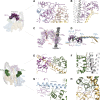Cryo-EM structure of the autoinhibited state of myosin-2
- PMID: 34936462
- PMCID: PMC8694606
- DOI: 10.1126/sciadv.abk3273
Cryo-EM structure of the autoinhibited state of myosin-2
Abstract
We solved the near-atomic resolution structure of smooth muscle myosin-2 in the autoinhibited state (10S) using single-particle cryo–electron microscopy. The 3.4-Å structure reveals the precise molecular architecture of 10S and the structural basis for myosin-2 regulation. We reveal the position of the phosphorylation sites that control myosin autoinhibition and activation by phosphorylation of the regulatory light chain. Further, we present a previously unidentified conformational state in myosin-2 that traps ADP and Pi produced by the hydrolysis of ATP in the active site. This noncanonical state represents a branch of the myosin enzyme cycle and explains the autoinhibition of the enzyme function of 10S along with its reduced affinity for actin. Together, our structure defines the molecular mechanisms that drive 10S formation, stabilization, and relief by phosphorylation of the regulatory light chain.
Figures





References
-
- Sellers J. R., Regulation of cytoplasmic and smooth muscle myosin. Curr. Opin. Cell Biol. 3, 98–104 (1991). - PubMed
-
- Sellers J. R., Myosins: A diverse superfamily. Biochim. Biophys. Acta 1496, 3–22 (2000). - PubMed
-
- Rayment I., Holden H., Whittaker M., Yohn C., Lorenz M., Holmes K., Milligan R., Structure of the actin-myosin complex and its implications for muscle contraction. Science 261, 58–65 (1993). - PubMed
-
- Geeves M. A., Review: The ATPase mechanism of myosin and actomyosin. Biopolymers 105, 483–491 (2016). - PubMed
Grants and funding
LinkOut - more resources
Full Text Sources
Research Materials
Miscellaneous

